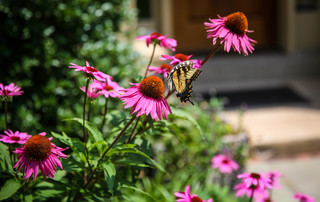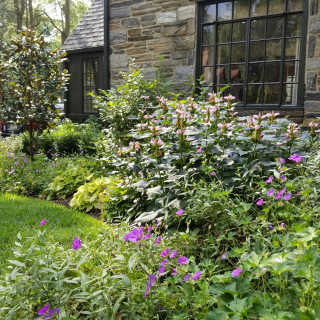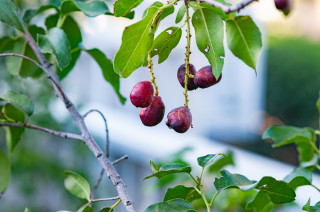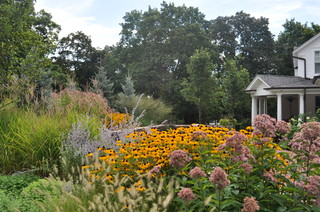
This article was originally published by a www.houzz.com . Read the Original article here. .

This article was originally published by a www.houzz.com . Read the Original article here. .

Focus on natives. Some of Deborah Gliksman’s favorite shrubs from California are the tall ‘Dark Star’ ceanothus (Ceanothus ‘Dark Star’, zones 8 to 10) and the smaller ‘Valley Violet’ ceanothus (Ceanothus maritimus ‘Valley Violet’, zones 8 to 10). Gliksman also recommends ‘Aromas’ sage (Salvia ‘Aromas’, zones 8 to 10), bush anemone (Carpenteria californica, Zone 9), ‘De La Mina’ Cedros Island verbena (Verbena lilacina ‘De La Mina’, zones 8 to 10), globe mallow (Sphaeralcea ambigua, zones 6 to 9) and St. Catherine’s lace (Eriogonum giganteum, zones 9 to 11). “They’re all stunning shrubs,” she says.
For perennials, Gliksman often uses yarrow (Achillea millefolium, zones 3 to 9), monkeyflower (Mimulus spp.), penstemons and Douglas iris (Iris douglasiana, zones 6 to 10). For ground covers, she loves ‘Silver Carpet’ aster (Corethrogyne filaginifolia ‘Silver Carpet’, zones 8 to 10), ground currant (Ribes spp.) and seaside daisy (Erigeron glaucus, zones 8 to 10).
What not to plant. Gliksman advises against using invasive plants. Besides possibly taking over your garden and even your neighborhood, she says, they can compete with native species and threaten biodiversity.
Your turn: What are your favorite low-maintenance plants to grow in your garden? Tell us in the Comments.
More on Houzz
Read more gardening guides
Get landscape design ideas
Find a landscape designer
Shop for gardening tools
This article was originally published by a www.houzz.com . Read the Original article here. .

Chicago is known for its brutally cold winters and hot, dry summers. “Just a few hours north and south of here is a very different climate,” says Jeff True.
Turn to native hardwoods. True says that native hardwood trees can handle weather extremes and are often his starting points. These include several maples, such as red maple (Acer rubrum, zones 3 to 9), sugar maple (A. saccharum, zones 3 to 8; shown here), silver maple (A. saccharinum, zones 3 to 9) and Freeman’s maple (A. x. freemanii, zones 5 to 8).
Native white oak (Quercus alba, zones 3 to 9), which is the state tree of Illinois, is also a tried-and-true favorite, as are swamp white oak (Q. bicolor, zones 3 to 8), Chinquapin oak (Q. muehlenbergii, zones 5 to 7) and shagbark hickory (Carya ovata, zones 4 to 8). “I personally love Kentucky coffeetree (Gymnocladus dioicus, zones 3 to 8) and hackberry (Celtis occidentalis, zones 2 to 9),” True says.
He adds that the new elm varieties resistant to Dutch elm disease, such as Triumph elm (Ulmus ‘Morton Glossy’, zones 4 to 7), are fast-growing, allowing them to fill in spaces quickly.
8 Reasons to Plant a Great Tree
This article was originally published by a www.houzz.com . Read the Original article here. .

While there are plants that establish better with a spring installation, here are some that do just as well, if not better, when they go into the ground in fall. They’ll be ready to help pollinators and other wildlife come springtime.
This article was originally published by a www.houzz.com . Read the Original article here. .

Purple coneflower and Russian sage make an all-star combination for late-summer and fall perennial beds. Purple coneflower (Echinacea purpurea, zones 3 to 8), native to Eastern North America, are cold-hardy perennials that bloom for months, attracting native bees and butterflies. After the bloom, the flowers’ spiky deep-orange centers can be left in the garden as decorative seedpods (and a feast for birds).
With its pale stems and delicate lavender-blue flowers, Russian sage (Perovskia atriplicifolia, zones 5 to 9) adds an airy quality to beds, appearing like a pale-colored cloud when planted in drifts. Russian sage blooms from July to October.
Both plants are drought-tolerant, making them a good pair for a tough, low-water spot like this sidewalk garden by Garden Stories in Portland, Oregon.
Water requirement: Moderate to low, once established
Light requirement: Full sun
20 Favorite Flowers for the Fall Landscape
This article was originally published by a www.houzz.com . Read the Original article here. .

The following are 12 edibles you can plant now that will extend your vegetable growing season well into the fall months. Some, like carrots and radishes, are familiar spring options that will grow quickly and help fill in any bare patches left when you pull out your spent summer favorites. For others, such as kale and turnips, fall is the optimal planting time and frost is a plus. If you’re in a warm-winter climate, vegetables such as chard might even keep producing well into winter.
This article was originally published by a www.houzz.com . Read the Original article here. .

Knowing your site will help you decide if you can plant a small tree, such as a dogwood, redbud or hawthorne, or if your yard can accommodate a large oak, pine or pecan. The function of the tree is also important to consider: Will it be multifunctional by providing screening, shade, noise reduction, cover for wildlife, erosion control or food? Discover below how you can place trees in the landscape to benefit both your home and the environment.
This article was originally published by a www.houzz.com . Read the Original article here. .
4. Pollinators Need More Than Just Flowers
Without foliage to eat, many youngsters and future butterflies, moths, flies and beetles would starve. The same can be said about pollen, which a lot of native bee species use to feed their young. Shallow flowers like asters (Symphyotrichum spp., zones 3 to 8, depending on sepcies) and sunflowers (Helianthus annuus, zones 2 to 11, depending on species) tend to attract a greater diversity of adult pollinators, but that doesn’t mean you should stick to that one form.
Additionally, try to use straight species where you can. These are native plants that have not been crossed or bred with others to produce new leaf colors or new flower colors and shapes. When plants are altered, the chemical makeup of their leaves may change and be unable to support as many caterpillars.